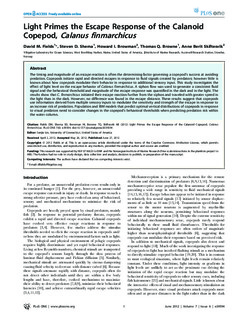| dc.contributor.author | Fields, David M. | |
| dc.contributor.author | Shema, Steven D. | |
| dc.contributor.author | Browman, Howard I. | |
| dc.contributor.author | Browne, Thomas Q. | |
| dc.contributor.author | Skiftesvik, Anne Berit | |
| dc.date.accessioned | 2012-12-03T12:15:53Z | |
| dc.date.available | 2012-12-03T12:15:53Z | |
| dc.date.issued | 2012-06-27 | |
| dc.identifier.issn | 1932-6203 | |
| dc.identifier.uri | http://hdl.handle.net/11250/109267 | |
| dc.description.abstract | The timing and magnitude of an escape reaction is often the determining factor governing a copepod’s success at avoiding
predation. Copepods initiate rapid and directed escapes in response to fluid signals created by predators; however little is
known about how copepods modulate their behavior in response to additional sensory input. This study investigates the
effect of light level on the escape behavior of Calanus finmarchicus. A siphon flow was used to generate a consistent fluid
signal and the behavioral threshold and magnitude of the escape response was quantified in the dark and in the light. The
results show that C. finmarchicus initiated their escape reaction further from the siphon and traveled with greater speed in
the light than in the dark. However, no difference was found in the escape distance. These results suggest that copepods
use information derived from multiple sensory inputs to modulate the sensitivity and strength of the escape in response to
an increase risk of predation. Population and IBM models that predict optimal vertical distributions of copepods in response
to visual predators need to consider changes in the copepod’s behavioral thresholds when predicting predation risk within
the water column. | no_NO |
| dc.language.iso | eng | no_NO |
| dc.publisher | PLoS ONE | no_NO |
| dc.subject | zooplankton | no_NO |
| dc.subject | dyreplankton | no_NO |
| dc.subject | copepods | no_NO |
| dc.subject | raudåte | no_NO |
| dc.title | Light Primes the Escape Response of the Calanoid Copepod, Calanus finmarchicus | no_NO |
| dc.type | Journal article | no_NO |
| dc.type | Peer reviewed | no_NO |
| dc.subject.nsi | VDP::Mathematics and natural science: 400::Zoology and botany: 480::Ethology: 485 | no_NO |
| dc.subject.nsi | VDP::Social science: 200::Library and information science: 320::Knowledge retrieval and organization: 323 | no_NO |
| dc.source.pagenumber | e39594 | no_NO |
| dc.source.volume | 7 | no_NO |
| dc.source.journal | PLoS ONE | no_NO |
| dc.source.issue | 6 | no_NO |
| dc.identifier.doi | http://dx.doi.org/10.1371/journal.pone.0039594 | |
